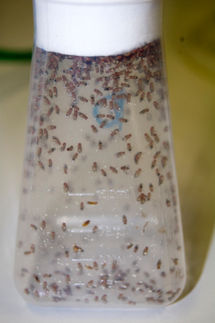Ancestral genome of present-day African great apes & humans had burst of DNA sequence duplication
The genome of the evolutionary ancestor of humans and present-day apes underwent a burst of activity in duplicating segments of DNA, according to a study to be published in Nature.
"The new study shows big differences in the genomes of humans and great apes within duplicated sequences containing rapidly evolving genes. Most of these differences occurred at a time just prior to the speciation of chimpanzees, gorillas, and humans,"said University of Washington (UW) researchers Tomas Marques-Bonet and Jeffrey M. Kidd who headed the study. Both are fellows in the lab of Evan Eichler, UW professor of genome sciences, a Howard Hughes Medical Institute investigator and senior author of the paper.
"It is unclear why, but the common ancestor of humans, chimps and gorillas had an unusual activity of duplication," Kidd added. "Moreover, we don't yet know the functions of most of the genes that were affected by these duplications."
The great ape ancestors, from whom humans, gorillas and chimps descended, lived in Africa between 8 million and 12 million years ago. Most scientists think that the lineage that eventually led to chimps and humans diverged from the African great ape ancestors about 5 million to 7 million years ago.
"What's exciting for us to learn," Eichler added, "was that sequence duplication acceleration occurred in an era when other types of mutations had slowed within the hominid (human-like) lineage."
"There was significant increase in genome activity in both the number of duplication events and the number of base pairs of DNA that were affected," Marques-Bonet noted. The results suggest that evolutionary properties of copy-number mutations, such as repeated segments, differ from other forms of mutations.
To understand the pattern and rate of genomic duplication during evolution, the researchers constructed a map of segmental duplications for four primate genomes: macaque, orangutan, chimpanzee, and human. They then compared the duplications across the four species. They characterized a duplication as shared if it occurred in two or more of the four species and lineage-specific if it was found in just one species. A small fraction of the duplicated content was human-specific, while the major part of duplications was shared with the other species.
"Our team found striking examples of recurrent duplications of DNA segments that happened independently in different lineages," the researchers said. "Most of the shared duplications were already present in the chimp-human common ancestor, but these are highly variable in copy number between and within human and great ape species."
Scientists have had difficulty determining why humans and chimps differ so much at a physical and behavioral level but are genetically so similar. Chimps and people share almost 99 percent of the non-duplicated sequences of their genomes; their proteins are virtually identical; and there are very few rearrangements that distinguish ape-human chromosomes. In contrast, the researchers noted that the duplicated sequences show much more variation than the other portions of the genetic code.
"There is still no final answer as to why chimps and humans are different," Marques-Bonet and Kidd said. "Maybe segmental duplications that are specific to humans are another layer to explore, or maybe the distinction between human and chimps is not found in these genetic differences.
"What is certain is that genetic differences contribute significantly to what makes a human and chimp different, and we know that these regions of our genetic code are changing much more rapidly than most others. The next challenge will be making sense of all these differences and the genes that are affected by them."
Most read news
Topics
Organizations
Other news from the department science

Get the life science industry in your inbox
By submitting this form you agree that LUMITOS AG will send you the newsletter(s) selected above by email. Your data will not be passed on to third parties. Your data will be stored and processed in accordance with our data protection regulations. LUMITOS may contact you by email for the purpose of advertising or market and opinion surveys. You can revoke your consent at any time without giving reasons to LUMITOS AG, Ernst-Augustin-Str. 2, 12489 Berlin, Germany or by e-mail at revoke@lumitos.com with effect for the future. In addition, each email contains a link to unsubscribe from the corresponding newsletter.





















































